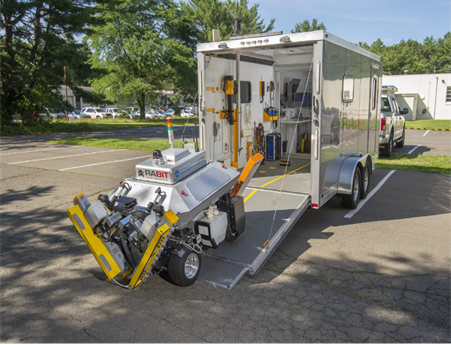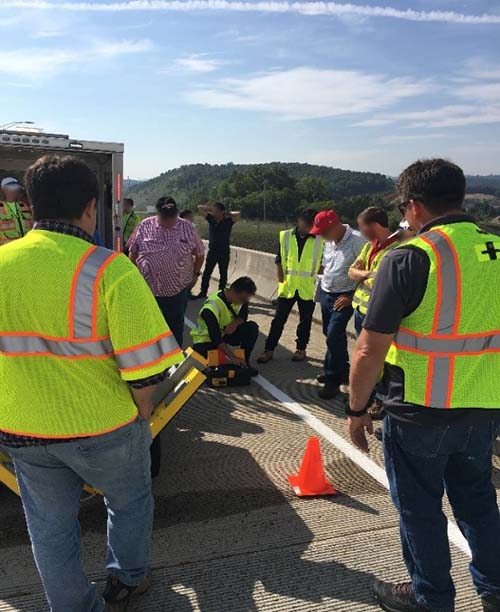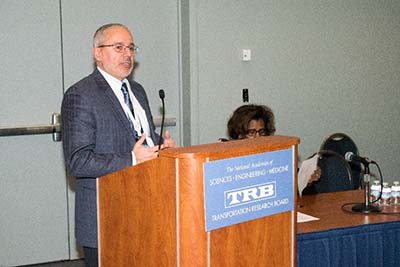U.S. Department of Transportation
Federal Highway Administration
1200 New Jersey Avenue, SE
Washington, DC 20590
202-366-4000
Federal Highway Administration Research and Technology
Coordinating, Developing, and Delivering Highway Transportation Innovations
|
LTBP NEWS This newsletter is an archived publication and may contain dated technical, contact, and link information. |
|
| Publication Number: FHWA-HRT-19-029 Date: Volume 7, Winter 2019 |
Publication Number: FHWA-HRT-19-029 Date: Volume 7, Winter 2019 |

PDF Version (818 KB)

Source: FHWA
RABIT being deployed from the systems operations center. The center is used to store and transport the equipment.
The Long-Term Bridge Performance (LTBP) Program is deploying newly acquired commercial versions of the RABIT™ (Robotic Assisted Bridge Inspection Tool). This system was developed to collect high-quality data using multiple nondestructive evaluation (NDE) technologies mounted on a single platform to assess the condition of bridge decks.
The RABIT™ includes several NDE technologies for assessing untreated (bare) concrete decks. These technologies include: ground penetrating radar (used to assess the condition of underlying concrete and to map the location and cover of the topmost reinforcement embedded in the concrete deck); impact echo (acoustic wave method used to detect the presence and extent of subsurface deck delaminations); ultrasonic surface waves (acoustic wave technology used to assess the quality of concrete through determination of the in situ concrete modulus); and electrical resistivity of the concrete deck (used to assess the potential for a corrosive environment). The RABIT™ also has two high-resolution cameras mounted on the chassis to capture images of the deck. The images are stitched together into one large composite image to provide documentation of the deck's surface condition.
With the implementation of this new tool, the LTBP Program is gearing up for another round of data collection in the Gulf and Northwestern States. The initial round of data collection on 24 bridges in the Gulf States and 24 bridges in the Northwestern States was performed in 2015; it included extensive visual inspections and deck material sampling (cores were removed and tested for chloride penetration and compressive strength). These bridges will be assessed with the RABIT™ during the 2018–2019 timeframe to collect high-quality data—using the NDE technologies described in the previous paragraph—to quantify the condition of the reinforced concrete bridge decks.
For further information about LTBP data collection, please contact Robert Zobel at 202–493–3024 or robert.zobel@dot.gov.

Source: FHWA
LTBP data collection contractors receive training on how to evaluate bridge decks using the RABIT™ at the Virginia Smart Road (August 2018).
The LTBP Program held a workshop to train the data collection contractor on how to use the RABIT™ to collect NDE data on bridge decks. The classroom and field training were conducted from August 14–16, 2018, at the Virginia Tech Transportation Institute (VTTI). The field training was conducted on the Virginia Smart Road located at VTTI. The attendees included the LTBP data collection contractor, manufacturers of the RABIT™, and staff from both the NDE Laboratory at the Turner-Fairbank Highway Research Center and the LTBP Program.
The LTBP Program is developing an in-house quality control/quality assurance (QC/QA) plan that will be used to ensure accuracy and consistency in bridge field data collection. The goal of the QC/QA plan is to implement a robust review process to verify that the field data collection procedures are being followed. The LTBP QC/QA plan will consist of periodic and independent field inspections, evaluations, and office reviews. The implementation of this plan will help to ensure reliability and consistency in LTBP's field data collection activities.

Source: FHWA
Dr. Jean Nehme, team leader for the Long-Term Infrastructure Performance Team.
It has been just over a year since Dr. Jean Nehme assumed team-leader responsibilities for the LTBP and the Long-Term Pavement Performance (LTPP) programs. Dr. Nehme retired from the Arizona Department of Transportation after 26 years of dedicated service to the citizens of the Grand Canyon State. He has held numerous leadership positions: State bridge engineer; State asset-management engineer; and until his retirement, the director of performance-management and research. He is a licensed professional engineer by the State of Arizona.
After the January 2017 retirement of Hamid Ghasemi, the previous LTBP team leader, Federal Highway Administration (FHWA) management began consolidating the LTBP and LTPP programs under one team because both have similar long-term performance objectives to address the Nation's infrastructure needs. In May 2017, the Long-Term Infrastructure Performance (LTIP) Team became official. This reorganization combined two teams, but both research programs will remain distinct and have separate, predefined goals and objectives.
FHWA is receiving feedback on LTIP programs from our external partners through the Transportation Research Board (TRB) Advisory Committee. The TRB LTIP Advisory Committee provides advice to FHWA management on programmatic issues, while expert task groups (ETGs) on bridges and pavement provide advice on technical aspects of the LTBP and LTPP programs, respectively.
Currently, the TRB Committee and technical ETGs meet annually to receive updates and information about both programs. The first set of meetings occurred between the fall of 2017 and spring of 2018. The second meeting of the LTIP Committee occurred in November 2018. The LTIP Committee writes an annual letter report to the FHWA Administrator with its recommendations on priorities for the two programs. Committee and ETG memberships consist of State DOTs, academia, and industry representatives.
The LTBP InfoBridge™ web portal was released at the TRB Annual Meeting in January 2019. The portal provides a user-friendly web application that includes intuitive tools for finding, viewing, and analyzing bridge performance information. The web portal gives users the ability to share data selections and summary reports efficiently. FHWA's goal is to make LTBP InfoBridge™ a comprehensive bridge performance portal that enables researchers to develop tools and products that will enhance the understanding of the performance of highway bridge assets, leading to more efficient design, construction, rehabilitation, maintenance, preservation, and management of those assets.
Since its release, LTBP Program staff have held two webinars demonstrating the capabilities of the portal. One webinar was for internal FHWA Division and Program offices and the second webinar was for external FHWA partners. Both webinars were well attended and nearly 99 percent of the attendees indicated that InfoBridge would be useful in their work. The LTBP Program staff have received invitations to present and demonstrate the web portal at local and national meetings inside and outside of FHWA. The recorded webinar can be accessed at InfoBridge Demonstration (External Partners).
The LTBP InfoBridge™ web portal can be accessed at https://infobridge.fhwa.dot.gov/.
In addition to cosponsorships from other TRB committees, the LTBP Program was pleased to receive sponsorship from the TRB Standing Committee on Structures Maintenance (AHD30) for the LTBP Session at the 2019 TRB Annual Meeting. The session included a welcome from the FHWA Executive Director, Mr. Tom Everett; FHWA's plans for a student LTBP data analysis contest; and presentations on: LTBP Program updates, data collection activities, and how InfoBridge™ is being used in research and education.
A webinar for LTBP State Coordinators will take place Wednesday, March 20. It will recap the presentations made at the session, discuss current program updates and the future direction for the program, and give coordinators the chance to ask questions of the LTBP Program staff. Register now for the webinar.
FHWA LTBP Summary—National Changes in Bridge Practices for Reinforcing Bars
FHWA-HRT-16-012
April 2016 [PDF]
Synthesis of National and International Methodologies Used for Bridge Health Indices
FHWA-HRT-15-081
May 2016 [PDF]
LTBP Program's Literature Review on Weigh-In-Motion Systems
FHWA-HRT-16-024
June 2016 [PDF]
FHWA LTBP Pilot Study Summary-Findings from The New Jersey Bridge Deck
FHWA-HRT-16-070
December 2016 [PDF]
Join us on Facebook and YouTube to find FHWA's latest news, information, and resources.


FHWA-HRT-19-029
HRDI-30/03-19(Web)E